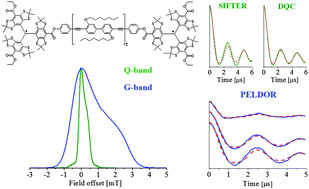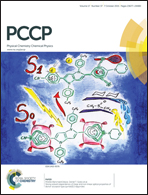Pulsed EPR dipolar spectroscopy at Q- and G-band on a trityl biradical†
Abstract
Pulsed electron paramagnetic resonance (EPR) spectroscopy is a valuable technique for the precise determination of distances between paramagnetic spin labels that are covalently attached to macromolecules. Nitroxides have commonly been utilised as paramagnetic tags for biomolecules, but trityl radicals have recently been developed as alternative spin labels. Trityls exhibit longer electron spin relaxation times and higher stability than nitroxides under in vivo conditions. So far, trityl radicals have only been used in pulsed EPR dipolar spectroscopy (PDS) at X-band (9.5 GHz), Ku-band (17.2 GHz) and Q-band (34 GHz) frequencies. In this study we investigated a trityl biradical by PDS at Q-band (34 GHz) and G-band (180 GHz) frequencies. Due to the small spectral width of the trityl (30 MHz) at Q-band frequencies, single frequency PDS techniques, like double-quantum coherence (DQC) and single frequency technique for refocusing dipolar couplings (SIFTER), work very efficiently. Hence, Q-band DQC and SIFTER experiments were performed and the results were compared; yielding a signal to noise ratio for SIFTER four times higher than that for DQC. At G-band frequencies the resolved axially symmetric g-tensor anisotropy of the trityl exhibited a spectral width of 130 MHz. Thus, pulsed electron electron double resonance (PELDOR/DEER) obtained at different pump–probe positions across the spectrum was used to reveal distances. Such a multi-frequency approach should also be applicable to determine structural information on biological macromolecules tagged with trityl spin labels.


 Please wait while we load your content...
Please wait while we load your content...